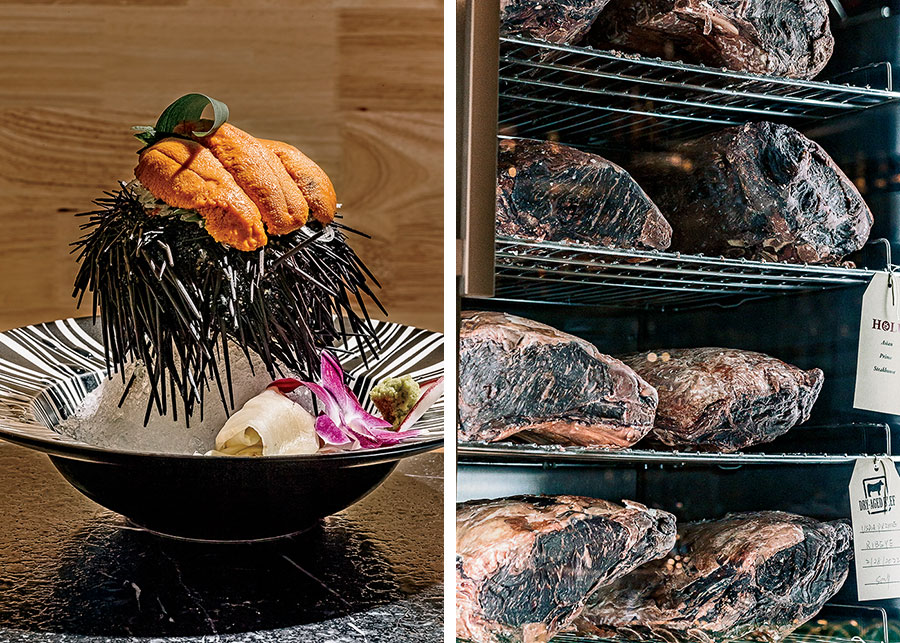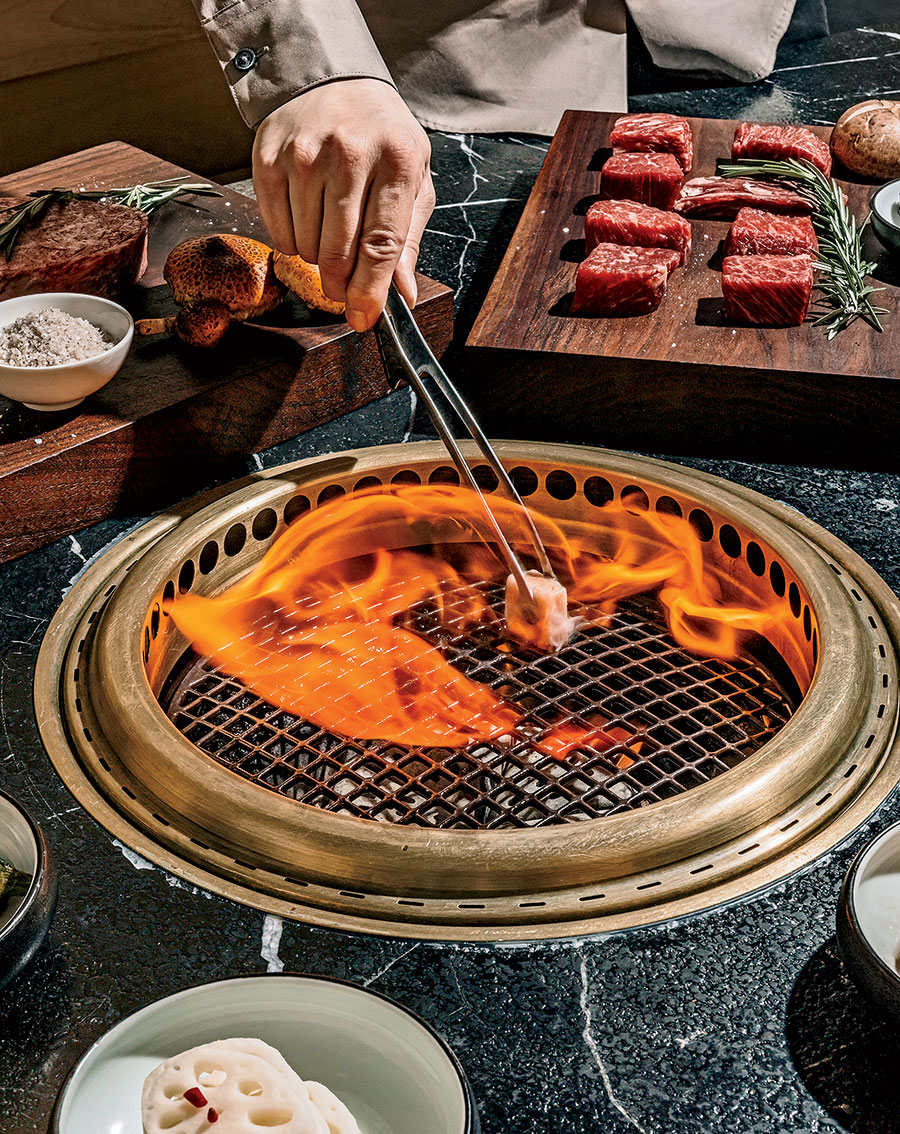If you sit at the bar at Holu, your eyes will be drawn to a bank of meat lockers taking up one wall. Prime rib eyes and New York strips dry-age inside them, and a massive bluefin tuna loin hangs from hooks. Above the lockers a message inscribed on slate stands sentry along the length of the wall: “Aging Enrich the Flavour of Life. Wine Intoxicate the Soul.”
My eyes keep going back to these ghostly hunks of cow and the curious tagline as we spend a good half hour at the bar, waiting for the occupants of our reserved table to skedaddle. Surprisingly great cocktails made by a harried lone bartender help pass the time. Weird chiaroscuro spotlighting shines here and there: on the meat in the lockers, on slick black tables set with bronze-ringed grills, and on us. Nothing about this place says we’ve entered Chicago’s most intriguing new steakhouse. That won’t be clear until the meat hits the table.
Set inside Jefferson Square, an East Pilsen mall home to a number of high-end Chinese food businesses, Holu marries the luxury ingredients of premium American steakhouses to the format of Asian table barbecue. While there is plenty of seafood and one great slab of pork, the menu is a beef eater’s dream. Specifically, it offers a world tour of wagyu, the richly marbled cuts from Japanese cattle breeds that are changing the way we eat beef.
Quick history lesson: Wagyu (literally “Japanese cows”) refers to one of four breeds of cattle bred to pull rice paddy plows. After the Meiji Restoration of 1868, the Japanese populace began eating meat and discovered these cattle stored a miraculous amount of delicious fat. The Miyazaki breed at the A5 level of marbling (Holu offers both rib eye and fillet) is the gold standard among imports. American and Australian wagyu cows are usually crossbreeds, less fatty but still with that melt-in-your-mouth beefiness.

Holu, which means “fire pit” in Chinese, is the first restaurant from owner Jason Song, who grew up in Shenyang, China, and came to Illinois as a finance student. He owes an obvious debt to Cote, the New York restaurant that pioneered this smart combination of dry-aged meat, fine drink, and downdraft grills. But while Cote hews closely to the conventions of Korean barbecue in packaging the meal, Holu takes a more pan-Asian approach in choosing side dishes and sauces. While these accompaniments taste like throwaways and Song badly needs an editor to help him execute his vision, he’s onto something great — the main meaty bites are a thrill.
When we finally sit down, we’re given more handouts than at a corporate retreat. There are menus upon menus, spirits and sakes, “carnival packages” and “meatarian packages.” We pass on the set menus and order one- or two-ounce portions of meat à la carte. Eight distinct cuts of wagyu from Japan, Australia, and the United States are on offer, and we want it all. After we place our order, some gratis apps arrive: a bowl of rice topped with a bit of salmon roe, a green salad in a dressing sweet enough to double as honey-bun glaze, and a shallow bowl of miso soup served with a silly gold teaspoon. It’s a weird start to the meal, but things improve immensely when our server fires up the grill and brings out our meat board, each piece glowing like a fat-striated ruby under the table spotlight. As veterans of many a Korean barbecue, we naturally grab the tongs, place a couple of pieces of meat on the grill, and — “No!” the server cries, snatching the tongs from my wife’s hand. “We do the cooking. How do you like it? Medium-rare?”
Tough question. The Aussie wagyu top sirloin cap makes a lovely medium-rare, as does the 45-day dry-aged prime New York strip. But the rib-eye cap should cook until you see the grain stripe, closer to medium. I have no idea how I like grilled tongue. (After trying it here, I’m going with medium.) That incredible A5 Miyazaki rib eye should be just a hair past rare. Our servers do fine work cooking the various cuts and snipping them into pieces for us to dip into either a finishing salt or a sweet fruit sauce.
I loved these bites but longed for traditional Japanese ponzu, a mix of soy sauce and citrus juice that cuts through the richness of fatty meat. I also wanted to wrest control of the tongs. The reason tabletop grills and hot pots are so popular in Asia has nothing to do with being hand-fed cubes of meat and everything to do with cooking your own food. It’s a fun group activity and a kind of jam session. Flip, move, dunk, eat, sip. Everyone gets into the rhythm.
On our second visit, we arrive with a game plan. For starters, we secure a semiprivate booth in the back rather than in the disco lounge front room. Then we order cocktails from that bartender, Todd Crummy, who uses small-batch spirits and Asian ingredients to fine effect. We order six ounces of meat apiece and, needing to add on a few bites to round out the meal, explore the appetizers. We order the otoro (bluefin tuna belly) sashimi, and though the $28 price tag makes me gulp, these two glorious pieces of fish are as big as dominoes. Wagyu dumplings look amazing, with lacy batter wings that rise from the plate like the Sydney Opera House, but burst with molten fat rather than broth.
While we don’t have the chutzpah to grab the tongs (next time), we do ask for soy sauce and cut lemons to make our own ponzu. Firing up the grill, we start with half of a live eel, one of my favorite bites at Holu. The inchlong pieces curl and sizzle, and the skin turns crunchy like a lightly carbonized potato chip. Also great: the Iberian pork secreto, the butcher’s “secret” shoulder cut from the world’s tastiest pork breed.
This gets me thinking that what I love about steakhouses isn’t just the steak. It’s the feeling of splurging, of having a menu filled with premium ingredients and a tacit promise that the kitchen will prepare them simply and with care. What Song does so brilliantly at Holu is swap out the luxuries of old — shrimp cocktail, veal chops, vintage Bordeaux — with those usually reserved for a sushi omakase or tasting menu. Uni, caviar, toro, all the wagyu. You can find a bargain pathway through this menu and enjoy the experience, or you can make a nervous joke about taking out a second mortgage and go for it. I say go for it.



